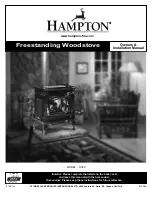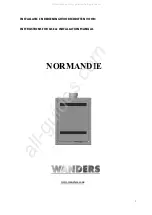
Page
14
of 28
Brightwell 400P
–
July 2022 v1
Pevex Stoves - Brightwell 400P
– Installation & Operating Manual
VENTILATION & COMBUSTION AIR
REQUIREMENTS
It is imperative that there is sufficient air supply to
the stove in order to support correct combustion.
The air supply to this appliance must comply with
current Building Regulations Part J, Heat Providing
Appliances. If another appliance is fitted in an
adjacent room it will be necessary to calculate an
additional air supply.
The minimum effective air requirement for this
appliance is 8.25cm². When calculating combustion
air requirements for this appliance use the following
equation:
550mm² per each kw of rated output above 5kw
should be provided, where a flue draught stabiliser is
DOWN DRAUGHTS
However well designed constructed and positioned,
the satisfactory performance of the flue can be
adversely affected by down draught caused by near-
by hills, adjacent tall buildings or trees. These can
deflect wind to blow directly down the flue or create
a zone of low pressure over the terminal. A suitable
terminal or cowl will usually effectively combat
direct down blow but no cowl is likely to pre- vent
down draught due to a low pressure zone. See
Fig.5
used the total free area shall be increased by
300mm² for each kw of rated output.
NOTE:
There must not be an extractor fan fitted in the same
room as the stove as this can cause the stove to
emit smoke and fumes into the room.
All materials used in the manufacture of air vents
should be such that the vent is dimensionally stable,
corrosion resistant, and no provision for closure.
The effective free area of any vent should be
ascertained before installation. The effect of any
grills should be allowed for when determining the
effective free area of any vent.
Air vents should be positioned so that they are not
liable to blockage.
Air vents direct to the outside of the building should
be located so that any air current produced will not
pass through normally occupied areas of the room.
An air vent outside the building should not be
located less than the dimensions specified within
the Building Regulations and B.S. 8303: Part 1 from
any part of any flue terminal. These air vents must
also be satisfactorily fire proofed as per Building
Regulations and B.S. 8303: Part 1.
Air vents in internal walls should not communicate
with bedrooms, bedsits, toilets, bathrooms or rooms
containing a shower.
Air vents traversing cavity walls should include a
continuous duct across the cavity. The duct should
be installed in such a manner as not to impair the
weather resistance of the cavity.
Joints between air vents and outside walls should be
sealed to prevent the ingress of moisture. Existing
air vents should be of the correct size and
unobstructed for the appliance in use.
Fig 4
Rear Exit
Flue
Position
Optional
External
Air
Position
FIG 5















































